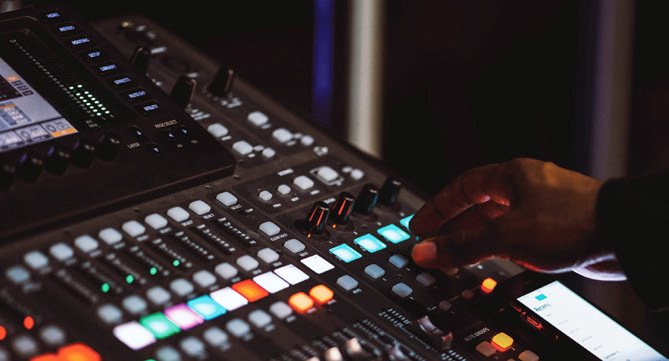We like to focus on the “do’s” when helping students build a better live music mix, but maybe a quick review of the “don’ts” isn’t such a bad idea. Solid, fundamental practices like good gain structure and proper use of EQ and dynamics are crucial in constructing a mix from the ground up, but what often derails our best intentions are “add-ons.”
In other words, extra ingredients meant to improve the flavor of one or more parts of the mix, but instead spoil the whole dish. Let’s have a look at some of these techniques and hopefully avoid some potholes that can send our mixes to the repair shop.
Combining Two Similar Inputs
Adding a second channel on instruments like kick drum, bass guitar and electric guitars has many benefits, but many unhappy (and unexpected) byproducts can be introduced into a mix.
For example, employing two microphones on kick drum is a very popular and can be a beneficial approach – when executed properly it provides the mix engineer with two separate tonalities that can be used independently or fused together. Interior boundary mics such as a Shure Beta 91 or Sennheiser 901 placed inside a kick drum on a pillow or dampening device can provide a tight, punchy sound with a nice snappy attack. Sometimes this single interior mic is all that’s needed, but what it provides in terms of control can be negated by a lack in depth in the “sub” frequencies.
On the other hand, a large-diaphragm mic, such as a Shure Beta 52 or Telefunken M82, mounted right in front of the outer head will offer a bigger, round low-frequency sound, but one that can be a little “loose” and tough to control if the sound system already has a lot of sub.
The interior mic may work better for up-tempo songs while the large-diaphragm mic is likely better suited for slower numbers. If you want the best of both worlds… use both! I like to employ varying amounts of each to achieve a good combination of attack/punch and big, round “subby” low end.
However, where it often goes wrong is in the summing of two low-frequency-rich mics and the almost certain distance offsets. The mic inside is much closer to the beater head while the other is generally placed just inside the hole cut in the front head. This distance differential can be anywhere from six inches to two feet.

When these two mics are combined the low frequencies can add at some frequencies, while cancelling at others. The inside mic on its own sounds cool, and so does the outside mic, but together, the low frequencies sound unpleasant or are reduced in level. This is classic phase cancellation caused by two signals being out of alignment.
Two weapons at your disposal for counteracting this issue are the polarity switch and input delay adjustment. Engaging the polarity switch on one of the channels reverses the polarity of the signal 180 degrees, which can sometimes help the two channels sound better… but not always.
The input delay function essentially “slows” the inside mic down until you match it with the later-arriving signal from the outside kick mic. Zero to 5 milliseconds (ms) of delay will usually get it all lined up and sounding great. Try the polarity switch first. If the combined sound improves but it still doesn’t sound perfectly in time, add a touch of delay to the inside mic in the area of zero to 3 ms. You can actually “tune” the combined sound by adjusting the inside mic’s input delay until you achieve the exact tonality you’re looking for.
Checks and balances: With one mic turned up in the sound system or in headphones, does the low-frequency content diminish or sound “hollowed out” when you add the second mic? If so, adjust polarity, time, or both.
All of the techniques described here for kick drums can also be applied when adding two different guitar mics together that are on the same speaker cone of a guitar cabinet. Let’s say the mics are a Shure SM57 and a Sennheiser 421. Different brands, different shapes, and sometimes slightly different output signals with respect to arrival times.
First, get each mic sounding best on its own, then blend the two together while listening for low or low-mid frequency cancellations. It may be subtle, but I often find the application of two different mics on the same guitar cabinet to sound slightly “phasey,” with a reduction of warm lows and mids while also introducing an unpleasant high-frequency bump.
Adding a very small amount of input delay to one of the mics can help fix this right up. Try the same process when adding a bass direct box (DI) and bass mic together.
Plugin Plights
Plugins are definitely the new “go-to” gadgets to improve, correct, and manage the sound of an input. Many of us own anywhere from one favorite plugin to entire bundles. They really are cool and offer features not available on many popular digital mixing boards.
But, I’ve witnessed both colleagues and students struggle when used improperly and have personally experienced degradation of my own mix when I’ve not played by the rules. Here are a few areas where danger lurks:
Multiband compressors. If you aren’t familiar, this is a compressor that splits the frequency range into bands (usually four) and lets you compress each band independently. When used correctly, an inconsistent vocal, an erratic bass guitar, or a thin sounding snare can come to life and become all that it was meant to be.
At the same time, I truly believe many sonic snafus originate with unsound use of this tool. Whenever a compressor (of any kind) is overused, the result is a substantially reduced signal that must have makeup gain applied to keep it relevant in the mix. This can be done with the makeup gain control on the compressor itself or by manually turning up the fader.





















